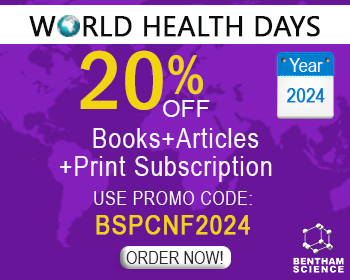Abstract
Background: Liver cancer is ranked as the fifth most prevalent and third most lethal cancer worldwide. The incidence rates of this cancer are on the rise, and only limited treatment options are available.
Methods: To identify and optimize the inhibitors of liver cancer cell-lines, a QSAR model was developed by using multiple linear regression methods. The robustness of the model was validated through statistical methods and wet-lab experiments.
Results: The developed QSAR models yielded high activity descriptor relationship accuracy of 91%, referred to by regression coefficient (r2= 0.91), and a high activity prediction accuracy of 89%. The external predicted (pred_r2) ability of the model was found to be 90%.
Conclusion: The QSAR study indicates that chemical descriptors such as to measure of electronegative atom count (Epsilon3), atom type count descriptors (MMFF_10), number of a carbon atom connected with four single bonds (SssssCE- index), molecular weight and, number of oxygen atom connected with two aromatic bonds (SaaOE-index) are significantly correlated with anticancer activity. The model, which was validated statistically and through wet-lab experiments, was further used in the virtual screening of potential inhibitors against the liver cancer cell line WRL68. ADMET risk screening, synthetic accessibility, and Lipinski's rule of five are used to filter false positive hits. AfterwardS, to achieve a set of aligned ligand poses and rank the predicted active compounds, docking studies were carried out. The studied compounds and their metabolites were also analyzed for different pharmacokinetics parameters. Finally, a series of compounds was proposed as anticancer agents.
Keywords: QSAR, Virtual screening, Drug designing, ADMET, Anticancer, Docking.
[http://dx.doi.org/10.1001/jamaoto.2014.1570] [PMID: 25068501]
[http://dx.doi.org/10.1080/08998280.2008.11928410] [PMID: 18628926]
[http://dx.doi.org/10.3390/cancers6031769] [PMID: 25198391]
[http://dx.doi.org/10.1186/s40169-018-0185-6] [PMID: 29541939]
[http://dx.doi.org/10.1016/j.drudis.2007.08.004] [PMID: 18061879]
[http://dx.doi.org/10.1016/j.drudis.2011.07.006]
[http://dx.doi.org/10.1038/nrd1032] [PMID: 12612645]
[http://dx.doi.org/10.1016/j.cbi.2006.12.006] [PMID: 17229415]
[http://dx.doi.org/10.1080/07391102.2016.1237382] [PMID: 27739336]
[http://dx.doi.org/10.1080/07391102.2016.1221364] [PMID: 27495391]
[http://dx.doi.org/10.1080/07391102.2016.1202863] [PMID: 27401212]
[http://dx.doi.org/10.1016/S0079-6468(02)41002-8] [PMID: 12774691]
[http://dx.doi.org/10.2147/DDDT.S51577]]
[http://dx.doi.org/10.1016/j.bmcl.2012.10.026] [PMID: 23102892]
[http://dx.doi.org/10.1016/j.bmcl.2006.01.077] [PMID: 16480866]
[http://dx.doi.org/10.1016/j.bmcl.2008.06.039] [PMID: 18586491]
[http://dx.doi.org/10.1007/s00044-011-9832-9]
[http://dx.doi.org/10.1021/jm801476y] [PMID: 19245212]
[http://dx.doi.org/10.1016/j.ejmech.2013.03.029] [PMID: 23584542]
[http://dx.doi.org/10.1002/(SICI)1096-987X(199604)17:5/6<553:AID-JCC3>3.0.CO;2-T]
[http://dx.doi.org/10.2174/09298673113206660330] [PMID: 24180274]
[http://dx.doi.org/10.1080/07391102.2017.1355846] [PMID: 28705120]
[http://dx.doi.org/10.1021/ci025554v] [PMID: 12546567]
[http://dx.doi.org/10.1002/qsar.19960150402]
[http://dx.doi.org/10.1002/cem.2488]
[http://dx.doi.org/10.1016/j.chemolab.2015.04.013]
[http://dx.doi.org/10.1159/000484062] [PMID: 29049989]
[http://dx.doi.org/10.1158/1078-0432.CCR-16-1203] [PMID: 27535982]
[http://dx.doi.org/10.1016/j.ymeth.2014.11.020] [PMID: 25484339]
[http://dx.doi.org/10.1080/14786419.2018.1530228] [PMID: 30580626]
[http://dx.doi.org/10.1021/acs.molpharmaceut.9b01080] [PMID: 32347728]
[http://dx.doi.org/10.2174/1568026620666200528155236]
[http://dx.doi.org/10.2174/1573409911309030012] [PMID: 23566359]
[http://dx.doi.org/10.1016/j.ejphar.2019.172482] [PMID: 31233749]
[http://dx.doi.org/10.1038/srep42717] [PMID: 28256516]
[http://dx.doi.org/10.1038/s41598-017-06131-0] [PMID: 28729623]
[http://dx.doi.org/10.1016/S1089-3261(05)70158-6] [PMID: 11218912]
[http://dx.doi.org/10.3748/wjg.v17.i41.4563] [PMID: 22147961]



























